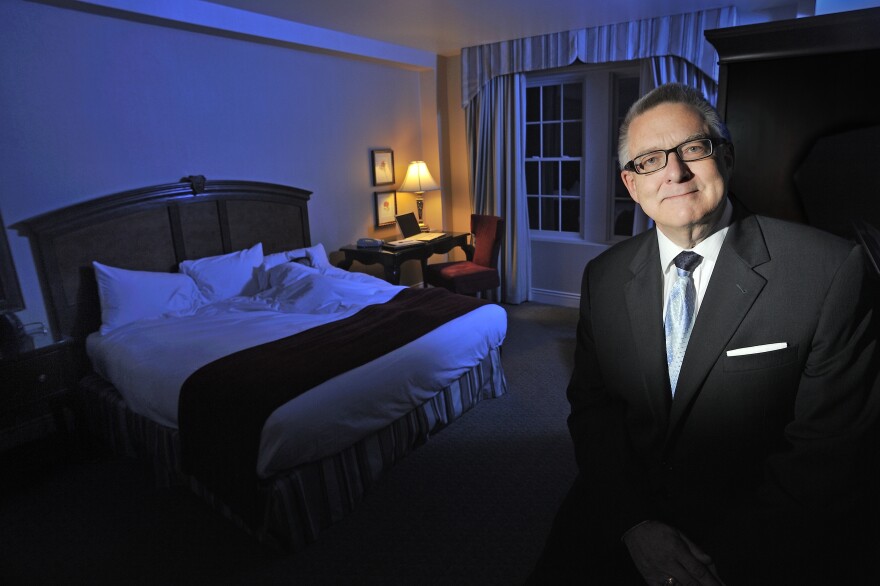A solid eight hours can be hard to come by in our non-stop, tech-saturated world. But the modern science of sleep shows that shut-eye is just as critical as diet and exercise in shaping both mental and physical health.
On this episode of The State of Things’ series “Embodied: Sex, Relationships and Your Health,” host Anita Rao speaks with experts in psychology, neurology, history and even lemur biology to better understand what is actually happening when we sleep and how we can learn to sleep better.
If I had no social obligations, no work and I lived in a cave, I would just want to go to bed later and later each day and wake up later and later each day. -Jade Wu
Rao is joined by Mary Ellen Wells, the director of the neurodiagnostics and sleep science program at the University of North Carolina School of Medicine; Jade Wu, a licensed clinical psychologist at Duke University specializing in behavioral sleep medicine and the host of the “Savvy Psychologist” podcast; Roger Ekirch, a university distinguished professor in the department of history at Virginia Tech and the researcher who brought to light an ancient pattern of segmented sleep; and Sheena Faherty, a science communicator who conducted doctoral research into hibernation in lemurs at the Duke Lemur Center.
The sleep experts break down the latest research into the science of sleep, how our ancestors used to sleep in two shifts with a period of wakefulness in between, and why lemurs may hold the key to human hibernation and deep space travel.

Interview Highlights
Jade Wu on what’s happening to our brains and bodies during deep sleep:
Human growth hormone peaks in how much it's being released in the body during deep sleep. So that's why kids need a lot of sleep, need a lot of deep sleep because they're growing. Sex hormones are also being released during this stage. That's why teenagers also need a lot of sleep, because they're going through puberty. And we're also consolidating memories … The brain is also doing some janitorial work — very important janitorial work. We're clearing out debris from the cerebrospinal fluid, just basically junk in the brain that we don't need. And with this clearing out, we're sort of resetting and we're maintaining brain health.
Wu on how we are programmed to have different circadian rhythms:
We are all biologically wired to be either a morning lark, a night owl or somewhere in the middle. And this is largely driven by genetics, so we can't help it. And there's actually differences in the length of our cycles depending on what we have. So for example, I'm a night owl. So I probably don't have a 24 hour cycle — I probably have something more like a 24.3 hour cycle. Meaning if I had no social obligations, no work and I lived in a cave, I would just want to go to bed later and later each day and wake up later and later each day. Whereas people who are morning people tend to have closer to a 24 hour cycle. Though the average I believe, is about 24.1 hours.
Mary Ellen Wells on the science behind sleepwalking:
So sleepwalking, it can be surprisingly common — about one to 15% of the population can suffer from sleepwalking at any point. And it's more common in children. And it's one of what we call a parasomnia, [those] are essentially acting out or movements, odd things that are happening during the night ... And there are certain parasomnia that happen during REM sleep and certain parasomnia that happen during non-REM sleep. Sleepwalking is one of those that happen during non-REM sleep. REM sleep is essentially your dreaming state. And sleepwalking — it's not entirely understood exactly why this happens to people. But there are many things that can spark it to happen, such as sleep deprivation … Sleepwalking is very, very dangerous. The person [is] not aware that this is happening. So there's a misperception out there that you should never wake a sleepwalker.
It was a prime time for petty crime. -Roger Ekirch
Roger Ekirch on what people did in the break between segmented sleep:
There were special prayers to be said after your first sleep. They meditated, many reflected upon dreams from whence they had just awakened. Others of course, used chamber pots. But then, still others left their beds, they performed chores. There's a wonderful passage in Virgil's Aeneid describing this. [They] performed chores that required very little light and virtually no skill in the dead of night. Some left their homes, visited neighbors or — I think even more commonly — pilfered apples from a neighbor's orchard. It was a prime time for petty crime. It was also, in the view of physicians writing in the 16th, 17th and 18th centuries, a prime opportunity in which to conceive children, after the first sleep when a couple would be more rested. In the words of Laurent Joubert, a French physician in the 16th century: It is after the first sleep when couples — and I'm quoting him verbatim — do it better and enjoy it more.
Sheena Faherty on the question of whether humans could possibly hibernate one day:
NASA is really interested in it because of things like space travel. And these types of things have applications to emergency medicine and organ transplantation.
...
What we find is that the same metabolic pathways, and genes that are involved in these metabolic pathways that are regulating these changes in metabolism [during lemur hibernation], are the same genetic pathways and genes that humans have already. And so in theory, humans have the capability to enter a torpor-like state based on this finding.
Note: This program originally aired October 16, 2019.



